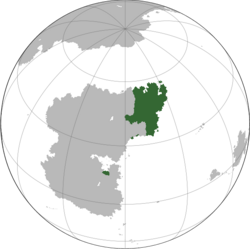East Stratean Free Travel Area: Difference between revisions
No edit summary |
No edit summary |
||
| (One intermediate revision by the same user not shown) | |||
| Line 27: | Line 27: | ||
Since border checkpoints were first placed during the [[First Great War]], several countries maintained open borders with each other, including Gagium and Saint Sienia, and several [[post-León Monarchy states]]. The 1986 [[XXX Agreement]] reaffirmed open borders between the former two, while they immediately entered negotiations with neighboring countries including Agnia. The 2002 [[Treaty of XXX]] which founded [[MASA]] included open borders between its four members. After joining the [[Trans-Tenific Partnership]] in 2004, the MASA countries negotiated an open border area with Gagium and Saint Sienia, culminating in the [[Chatrois Agreeement]] in late-2004, which came into effect on 1 June 2005. | Since border checkpoints were first placed during the [[First Great War]], several countries maintained open borders with each other, including Gagium and Saint Sienia, and several [[post-León Monarchy states]]. The 1986 [[XXX Agreement]] reaffirmed open borders between the former two, while they immediately entered negotiations with neighboring countries including Agnia. The 2002 [[Treaty of XXX]] which founded [[MASA]] included open borders between its four members. After joining the [[Trans-Tenific Partnership]] in 2004, the MASA countries negotiated an open border area with Gagium and Saint Sienia, culminating in the [[Chatrois Agreeement]] in late-2004, which came into effect on 1 June 2005. | ||
357 million people live within the ESFTA, which has a combined GDP of ₭12.2 trillion, and covers an area of 3.4 million square kilometers. Gagium alone accounts for 2/3 of the ESFTA population, 3/4 of the GDP, and 3/4 of the land area. An estimated 1.2 million people regularly commute across national borders. | |||
==History== | ==History== | ||
Latest revision as of 19:26, 8 October 2023
This article is incomplete because it is pending further input from participants, or it is a work-in-progress by one author. Please comment on this article's talk page to share your input, comments and questions. Note: To contribute to this article, you may need to seek help from the author(s) of this page. |
 Map of ESFTA members | |
| Type | Open border area |
|---|---|
| Established | 1 June 2005 |
| Members | |
| Area | 3,441,636 km2 (1,328,823 sq mi) |
| Population | 356,740,924 |
| Density | 103.65/km2 (268/sq mi) |
| GDP (Nominal) | ₭12.2 trillion |
| GDP per capita | ₭34,257 |
The East Stratean Free Travel Area (ESFTA) is an open border area comprising of Agnia, Atocha, Gagium, the Patriarchate of Mavona, Saint Sienia, and the Shkodër Federation. All states have abolished all passport controls and customs checks on their mutual borders, with the exception of the Agnian territory of Amador, though citizens of all member states can travel there with just minimal identification documents. Citizens of all members states can freely live and work in all members, and they maintain a common visa policy which is treated as a single jurisdiction for international travelers.
Since border checkpoints were first placed during the First Great War, several countries maintained open borders with each other, including Gagium and Saint Sienia, and several post-León Monarchy states. The 1986 XXX Agreement reaffirmed open borders between the former two, while they immediately entered negotiations with neighboring countries including Agnia. The 2002 Treaty of XXX which founded MASA included open borders between its four members. After joining the Trans-Tenific Partnership in 2004, the MASA countries negotiated an open border area with Gagium and Saint Sienia, culminating in the Chatrois Agreeement in late-2004, which came into effect on 1 June 2005.
357 million people live within the ESFTA, which has a combined GDP of ₭12.2 trillion, and covers an area of 3.4 million square kilometers. Gagium alone accounts for 2/3 of the ESFTA population, 3/4 of the GDP, and 3/4 of the land area. An estimated 1.2 million people regularly commute across national borders.
History
Early agreements
Chatrois Agreement
ESFTA today
Membership
The following six countries have been in the ESFTA since its foundation in 2005:
Comparison
Future members
Internal borders
No internal border controls exist within the six ESFTA members.
The one exception is the Agnian territory of Amador, where identification documents have to be shown when entering and exiting, even to and from Agnia. However, citizens of ESFTA states need to show minimal identification documents, only a national ID card or driver's license is sufficient. Citizens of ESFTA states are still allowed to freely to live and work in Amador.
Temporary border controls
Members can temporarily set up border checks for the following reasons: